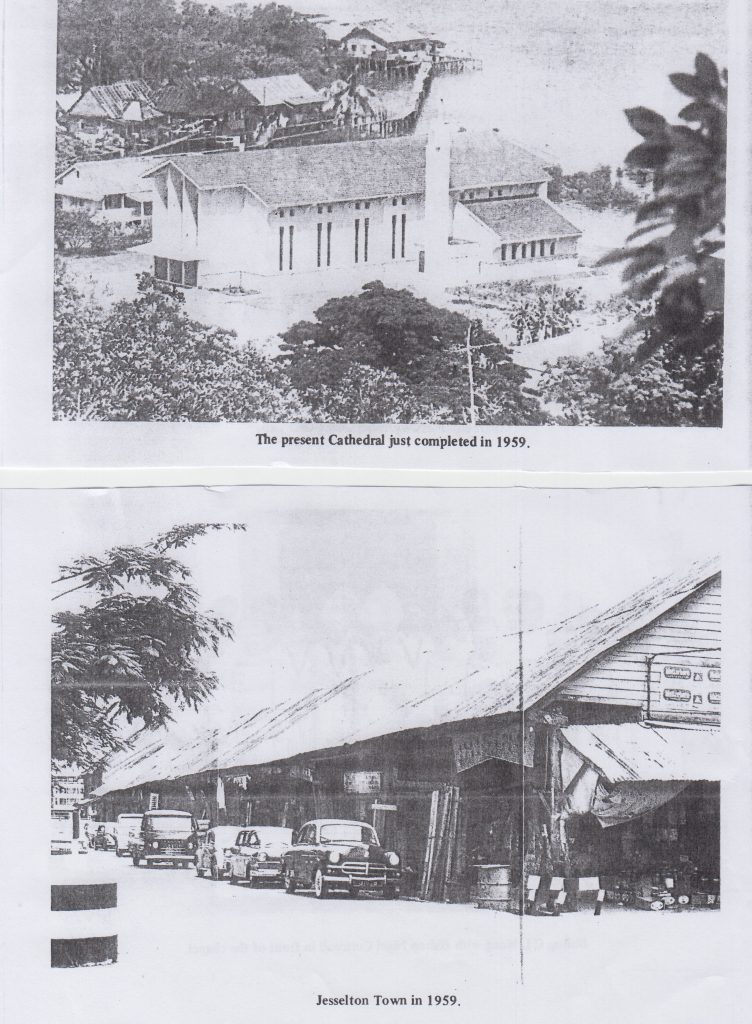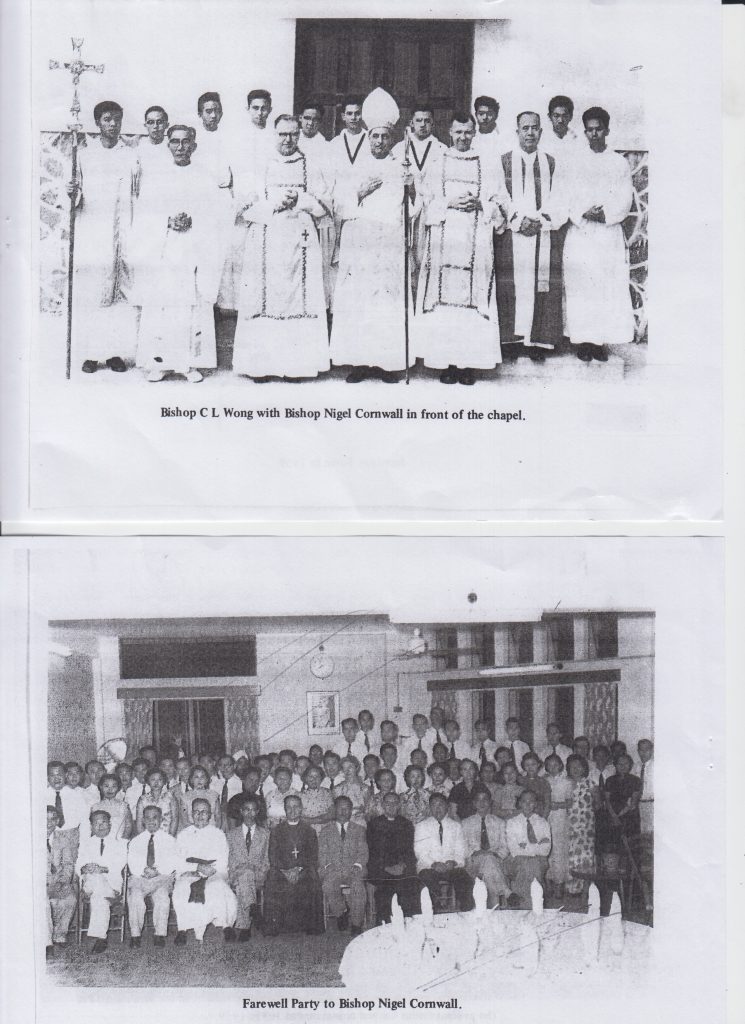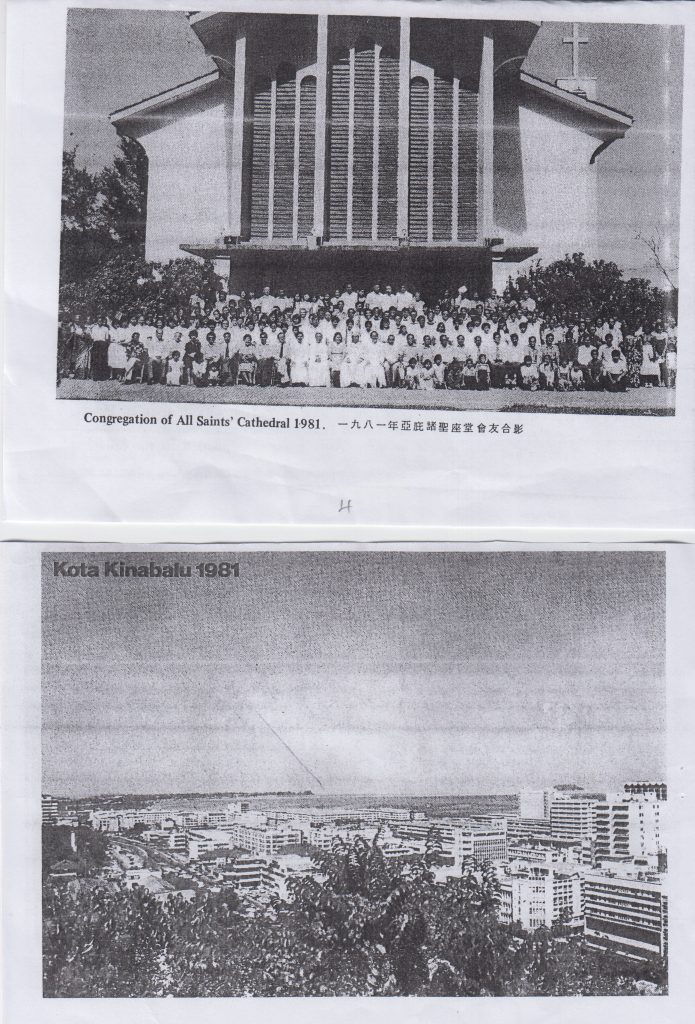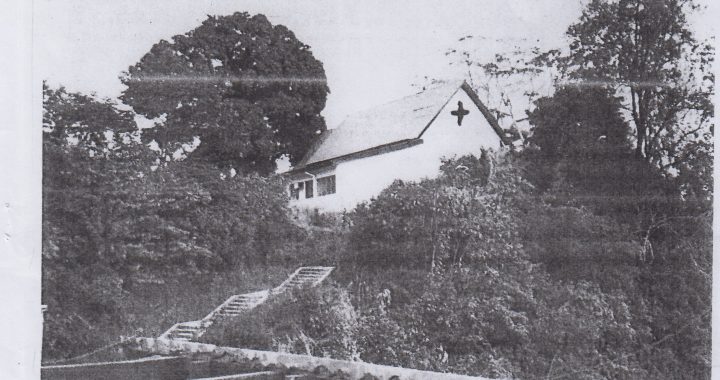Bishop Yong Chen Fah
I. THE HUMBLE BEGINNING
The History of the Anglican Church here goes back further than three quarters of a century, for in 1903 – only four years after the town was founded – an Anglican school was opened. It was named after the reigning monarch, King Edward VII’s school, and was situated somewhere in the Karamunsing area. Even before that the Bishop had visited Jesselton and approved a site for the new church to be built in Atkinson Road and at the same time he dedicated the cemetery which was adjoining the church site. The school was used as a meeting place for Anglicans, and services and committee meetings were held there. Later the site in Atkinson Road was abandoned in favour of a site nearer to the school. Perhaps, the people had decided that they would prefer the church to be near the sea, or maybe they had become used to the idea of church and school being closely linked. It is true to say that the history of the Anglican Church in Jesselton is also a history of the Anglican Schools, for they have always been closely united. In February 1951, the then Rector, Revd. Bowler said at a Parish Council meeting “The Mission is a single entity, the Church and the Schools having the same aim. The Church is one family and we must ensure that this is a living reality……” At that meeting the membership of the Parish Council was widened to include the Principals of the Schools, and they still automatically become members of the Parish Council until recent years due to changing conditions.
By 1910 the school had outlived its first building; and it was in the ‘new schoolroom’ that the decision was made to begin building a church. In August of that year Bishop Mounsey visited Jesselton, and it was decided to apply for a site on the hill above the school. The Public Works Department in Sandakan was asked to draw up the plans and the Supervisor of the Public Works Department Mr. A. Johnson was responsible for designing the church. (The old church on the hill opposite the present Cathedral).
Going back to the early history of the church in Jesselton, it was reported by the Revd. C. J. Collis in 1924 that church activity began in 1903 in Jesselton. By 1905, the S.P.G. Annual Report reported that “there is also a considerable number of Europeans and Chinese communicants at the new town of Jesselton”. In 1907, there was a new parsonage and school with 500 dollars already in hand for a church. Revd. Elton used to come over from Sandakan to minister to this newly formed congregation. Then in 1907 the Revd. Leggatt became the Priest in-charge of Jesselton and Labuan when Revd. Elton went on furlough. In 1910 and early 1911, the new Church was slowly rising. A day of general rejoicing was chosen for the laying of the Foundation Stone on 22nd June 1911, the Coronation Day of King George V. On the same day the Roman Catholic Church of the Sacred Heart, on another hill further along South Road was dedicated. The Foundation Stone then laid had been incorporated in our new Church and rests behind the altar. Another public holiday, Charter Day, was chosen for the opening of the Church; this was 1st November 1911, All Saints’ Day. Early in the morning of that day there was to be a parade at Victoria Barracks, and so a special train was hired so that people could go to the parade and get back for the opening service which was to be held at 8.00 a.m. The service was conducted by the Revd. F.W. Leggat and the Revd. Fong Hau Kong was also there; he had brought the School Master and choir from Kudat. A pastoral letter from the Bishop was read out, as he was not able to be present. After the opening there was a wedding at 10.00 a.m. being the first wedding – Mr. & Mrs. Wong Vui Tshin, Mr. Wong Shin En was Catechist. This was conducted in Chinese and was followed by a celebration of Holy Communion which was attended by 150 people. The whole church was completed sometime in 1912 but a Vicarage and two schools were still needed to complete the Station buildings. Some money for the purpose was already in hand, and encouraging promises of support had been received.
Another organization which was responsible for raising funds for the Church and Schools was the ‘Church Worker’s Association’. In 1923, they held a fete at which $1,644 was raised. Part of this money went to a new organ fund. There was already an organ in Church at the time, for in August 1921, at a wedding conducted by the Revd. C. J. Collis, Mr. Boland, the organist ‘performed energetic and musical service at the organ’. A new organ was decided in 1923.
In 1924, Revd C. J. Collis reported with great joy the acts of communion exceeding 1000 during that year. Signs of growth of the congregation were shown. The inadequacy of space and the difficulty of accommodating the worshippers with comfort, especially at great festivals was becoming apparent. The little church on the hill had now given twelve years’ service. It had a verandah running along each side and was painted black inside and out except in the Chancel where Revd. Collis had painted the wall behind the altar in red and gold squares, and the ceiling above in blue. The Church was now too small to accommodate all the congregation, and so the verandahs were enclosed to make the nave larger.
In 1927, one of the five local men, Chin Phu Yin (later was made a Canon of the Diocese of Jesselton in 1962 when Sabah became a Diocese) was ordained priest and stationed at All Saints’ Church, to assist the expansion work in Jesselton and Labuan.
With 1936 came to Silver Jubilee. The church and two schools were now well established, and it was felt that it was time for rejoicing. To commemorate the laying of the Foundation Stone, a concert was held in the cinema hall. Bishop Hudson came to Jesselton for the Special Services. On the Vigil of All Saints’ there was a confirmation at which fifty were confirmed, there was also a festal Evensong. On All Saints’ Day a solemn Eucharist was held as an act of Thanksgiving. Celebrations were continued on 3rd November when an At Home and Tea Party was held at All Saints’ School. This was attended by 250 people; it was followed by Evensong at which the Bishop preached. On 7th November, the two schools held a sports meeting on the padang, and at a service on the 8th both the Rector and Bishop preached. The small children were not forgotten, for they had a tea party on the 14th which was followed by games and races.
At the time of the celebration of the Silver Jubilee of the Church, it was thought fit to start a thanksgiving fund to build a new and worthy Church.
II. THE WAR 1942-1945
So the Church looked forward, it could not have foreseen the dark days ahead. But on the first day of January 1942, the Japanese invaded Borneo, and eight days later Jesselton was captured. Shortly afterwards the Europeans were interned, and the Church commandeered and used as a Radio Station.
When the war ended, it was some time before things were ‘back to normal’. Indeed, it was impossible ever to pick up the threads exactly as they had been dropped. The post-war world presented its own problems – the immediate ones of repairing and restoring to use the Church, rectory and school buildings – the long terms ones of building a new Church, expanding and rebuilding the schools, and also being alive to the missionary opportunities which presented themselves.
So, the Church was renovated for worship. In June 1953 the Foundation Stone of All Saints’ school was laid on a new site in Likas 3-1/2 miles from the town centers. The hill on which present Church and St. Agnes’ school stand was exchanged for the new All Saints’ school site and St. Agnes’ school site with 15 acres of land. Meanwhile the Church had again become too small for the congregation. It could only pack some one hundred and fifty people in and for a number of years the morning services had to be held in relays.
III. THE NEW CHURCH ON A NEW SITE – 1959
In all the plans being made for Jesselton, missionary endeavour was not forgotten. On 2nd June 1957, the Bishop laid the Foundation Stone of the new Church on the site vacated by All Saints’ School in Karamunsing, forty-six years later after the first stone was laid – the only stone in our wooden church on the hill. The new Church was built to accommodate more than twice as many people. It is in modern style, allowing for a high altar, a lady chapel and a proper front. In 1958, a commission was set up by the Bishop to consider the extension of church work in the Jesselton area – one of the resolutions passed was that “A Mission District be formed from the Parish of Jesselton to include the towns of Papar, Beaufort, Tenom and Keningau and their districts, the Priest to be resident at Beaufort, and while this district would be independent in organization, the Parish of Jesselton would pledge itself to foster this work by prayer and practical effort”. The Work ‘up the line’ continued, and Jesselton pledged itself to donate $5000 annually towards the work of the North Borneo Interior Mission.
When the Golden Jubilee was celebrated with great joy in 1961, the new church supposed to be the tallest building around the Karamunsing area, and painted with white and red roof was completed and dedicated in 1959. Together with the church was the rectory and a priest house. The parish hall was built and dedicated in 1967.
When Sabah was calved out from the Diocese of Borneo to form a new Diocese of Jesselton in 24th July 1962, All Saints’ Church was large enough to be made the Cathedral of the Diocese. Bishop James C. L. Wong who was the assistant Bishop of Borneo became the first Bishop of Jesselton. On the formation of the new Diocese of Jesselton, Bishop Wong installed Revd Chin Phu Yin, Revd Walter Newmarch, Revd Edward Rusted and Revd Frank Lomax Canons of the Cathedral.
As a Parish Church as well as the Mother Church of the Diocese, All Saints’ Cathedral’s role in the Diocese grew. Fr. A. E. Burn was made the first Dean, which was followed by Dean Tsu in 1969, and Archdeacon Briggs in 1973. The periods in between were filled in by Bishop Tan Sri Roland Koh and Bishop Datuk Dr. Luke Chhoa. And finally, a local Dean was appointed in the person of Dean Yong Chen Fah who was a student in St. Patrick’s School Tawau and All Saints’ School.
IV. ERA OF MILD PERSECUTION, 1970 – 1976
It has been said that the church that suffers will grow. This is true in Sabah from 1970 – 1976. In fact, the church must always be ready to suffer for Christ. During the period of 1970 – 1976, all expatriate missionaries working in the Diocese except Miss Marianne Wise, a nurse and Miss Sylvia Jeans, a teacher and Archdeacon Briggs were asked to leave Sabah when their work permits expired. Many of the Roman Catholic expatriate priests and other churches suffer the same fate.
However, during this period of suffering, though our member of local priests were very few, yet it was the time when our lay people were challenged to stand for Christ. This happened in various forms.
Firstly, the lay people began to realize that they have the responsibility to support their church in stewardship giving, and to assist their priests in pastoral work as well as evangelism.
Secondly, some key lay people in the person of the late Revd Fu Yun Fatt, the late Canon Kok Yu Kong and Canon Lee Syn Hon, and latter Revd Yapp Foh Yu, and the late Revd Liew Tat Lip, Revd James Lo and Revd Canon Martin Yuen responded to the situation by offering themselves as non-stipendiary priests. These are men who had been tested in their profession and faithful to the Lord and to the Anglican Church.
Thirdly, the Anglican young people responded to the situation with some among the young people with Form 5 and Form 6 standard going to the full-time ordained ministry. Among those from All Saints’ were: Revd Moses Chin, Revd Daniel Vun, Revd John William, Miss Lily Chong, Revd William Vun (Christ Church), Revd Albert Vun (Christ Church), Revd Herbert Tong (St. Michael’s Church), Revd Victor Leong (St. Michael’s Church), Revd Koo Tuk Su (St. Patrick’s Church), Miss Margaret Chong (Kudat), Miss Dorothy Chia (Lahad Datu). This process began to snowball and it affected the interior young people as well. Among those responded to the ordained ministry are Revd Gehing Lidis, Mr. Musa Ambai, Mr. Melter Tais, Mr. Wilson, Miss Judy from Lahad Datu. Now the Chinese speaking ones are Mr. Joseph Liew, Miss Chong Mui Ling, and Mr. James Lee from All Saints’ as well.
So, the persecution has done us a lot of good in self-reliance towards God. And from 1974-1987 the Cathedral congregation has grown to three main congregations: English (400-500), Chinese (150-200) and Bahasa Malaysia (350-400). Financially we have grown six folds. In 1986 we were able to complete the daughter church project in Penampang costing $1.4 millions, and at the same period 1980-1987 we had completed the parish hall extension, two staff quarters and the parking areas in front of the Cathedral. In 1986 the Diamond Jubilee was celebrated with great joy and with greater vision for the Lord. As a gratitude to the Lord’s Grace over the 75 years of church growth, the Cathedral sign board was erected to mark the occasion, with the dedication of the daughter church on 1st June.
Three more acres of land were added to the Cathedral compound in 1976, and in 1986 the Cathedral Chapter and the Parochial Church Council with the approval of the Diocesan Standing Committee this land is set aside for bigger ministry of the Cathedral in the years to come. The Lord has graciously set the vision for the Cathedral for greater things to come; and the people of God in the Cathedral are ready for it. At the Annual General Meeting in 29 March 1987, it was resolved that the present congregations be doubled in 2-3 years. If every member of All Saints’ Cathedral is a disciple maker, it will only take one year to double the capacity. As we celebrate the 25th anniversary of the Diocese, the strength of the Diocese has grown from 12,000 to 25,000, clergy and parish workers total are 27. All Saints’ is planning to build another daughter church in the future but in Kota Kinabalu areas, the vision is 6 churches in the next 15-20 years.
To conclude, All Saints’ is a giving Church with vision to grow spiritually and numerically. The Lord also wants All Saints’ to become a sending church – sending out missionaries to other parts of the world to preach the Gospel of Jesus Christ. It is also the family of God where the ministry of reconciliation, love and healing are exercised by its members who are the living members of Christ’s body.





